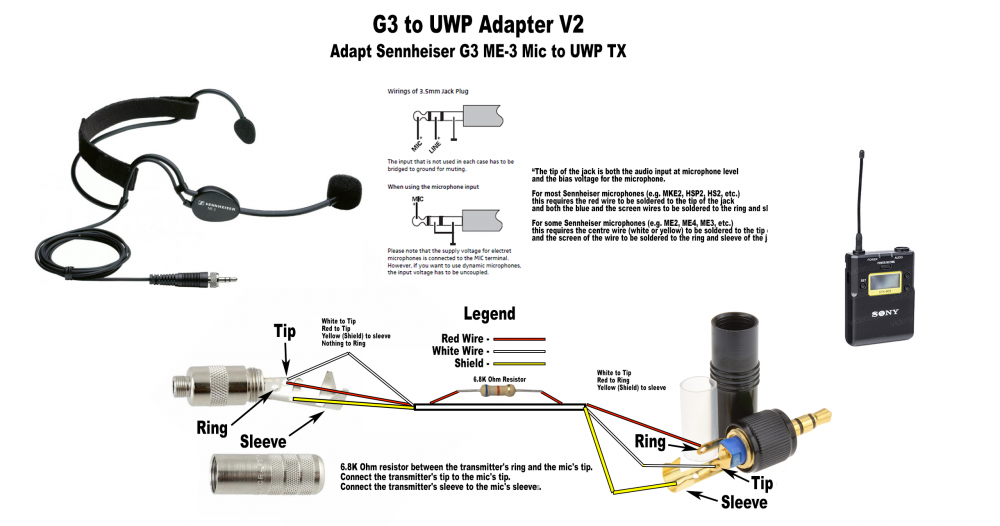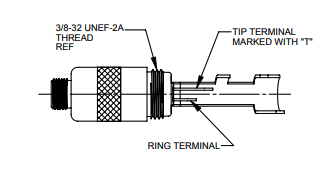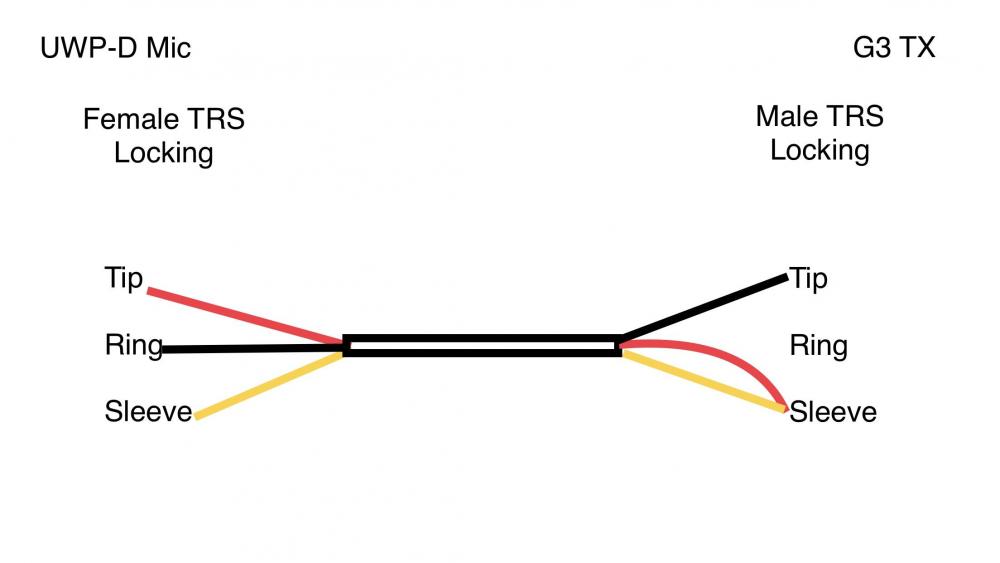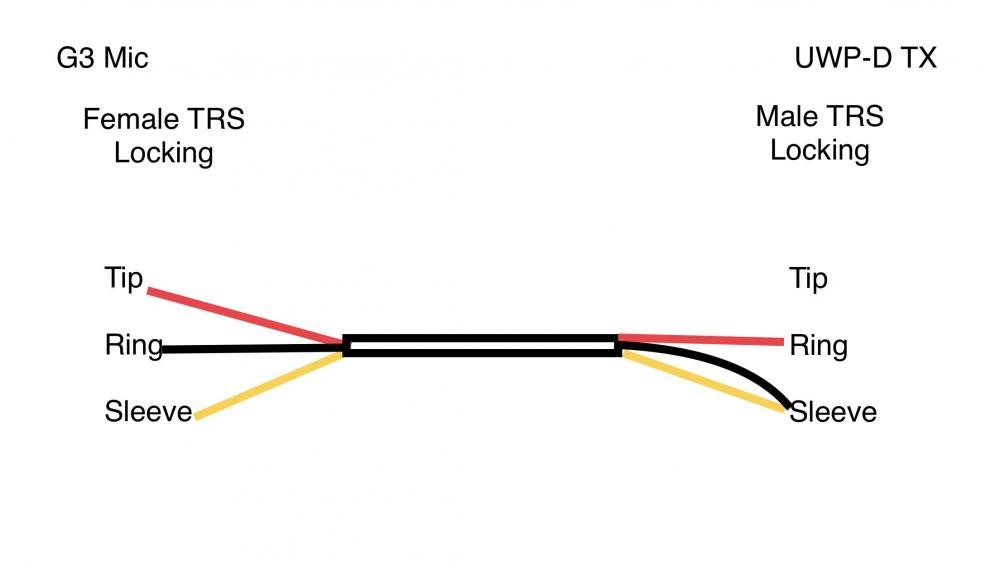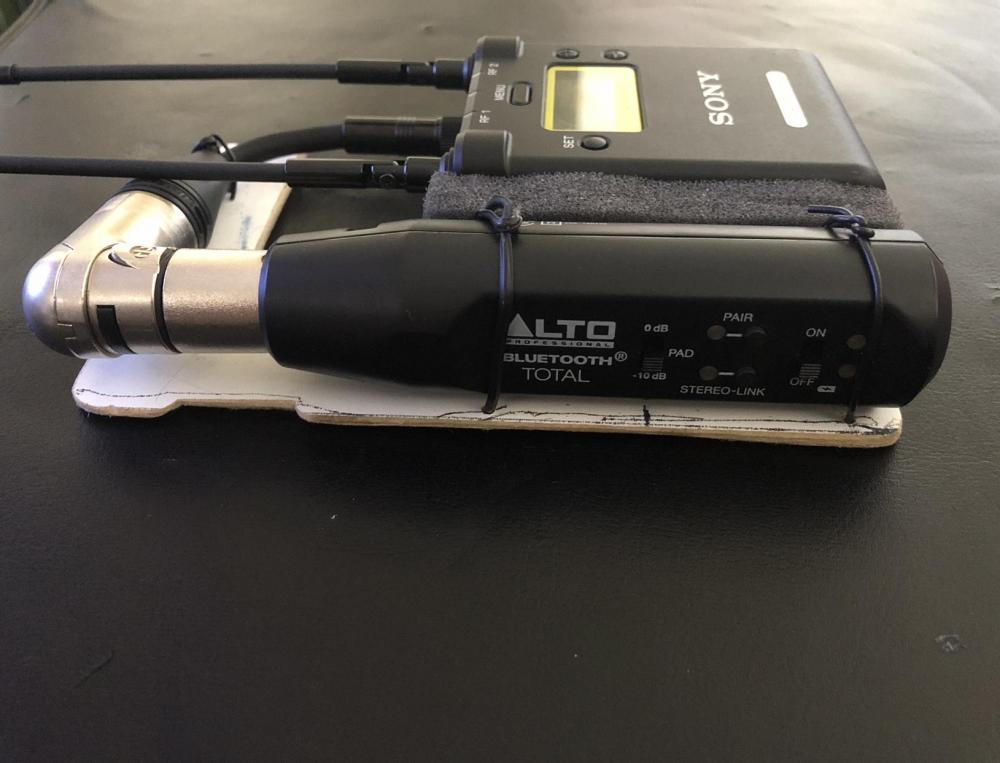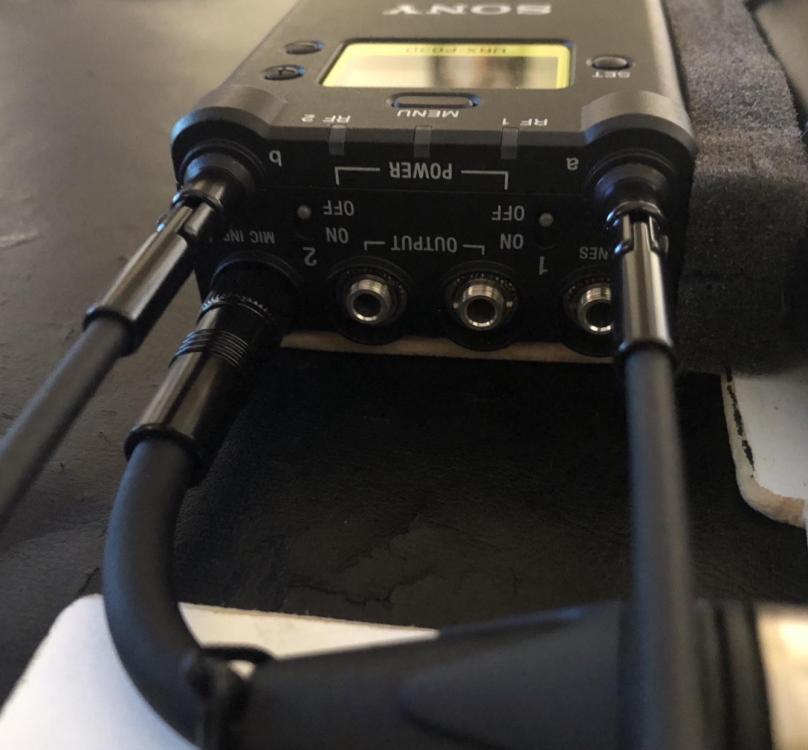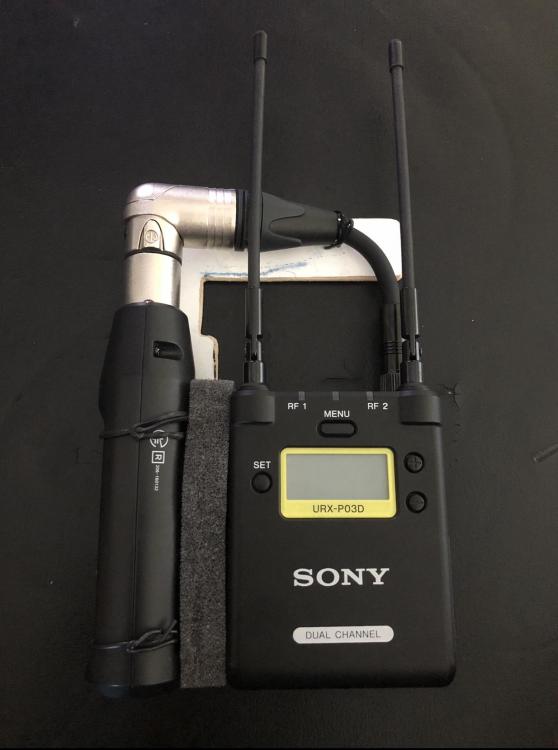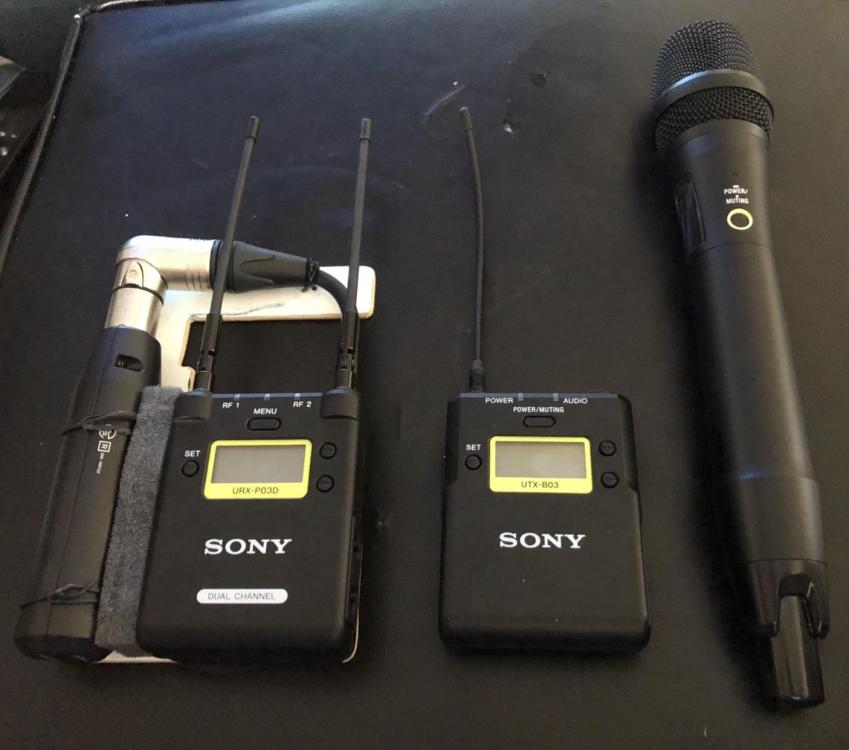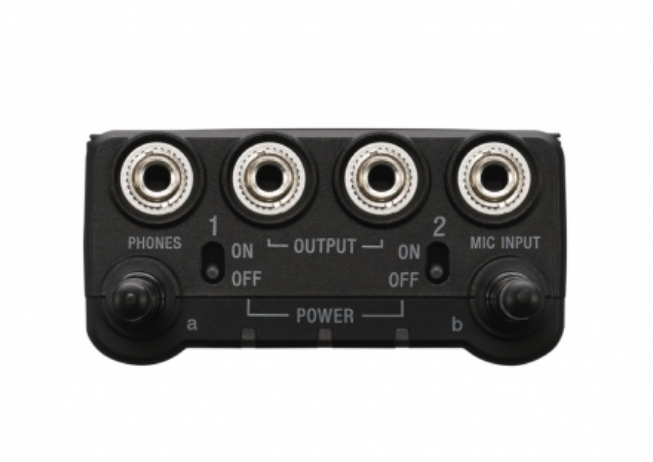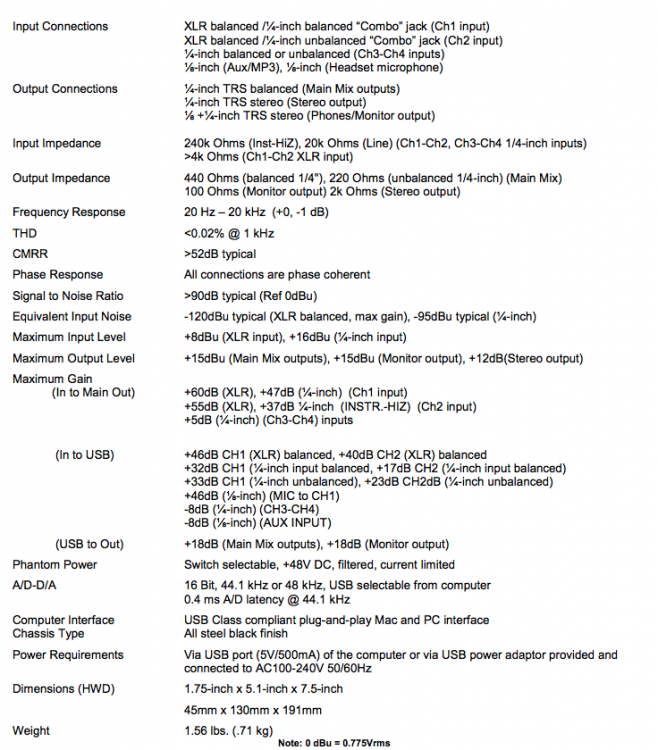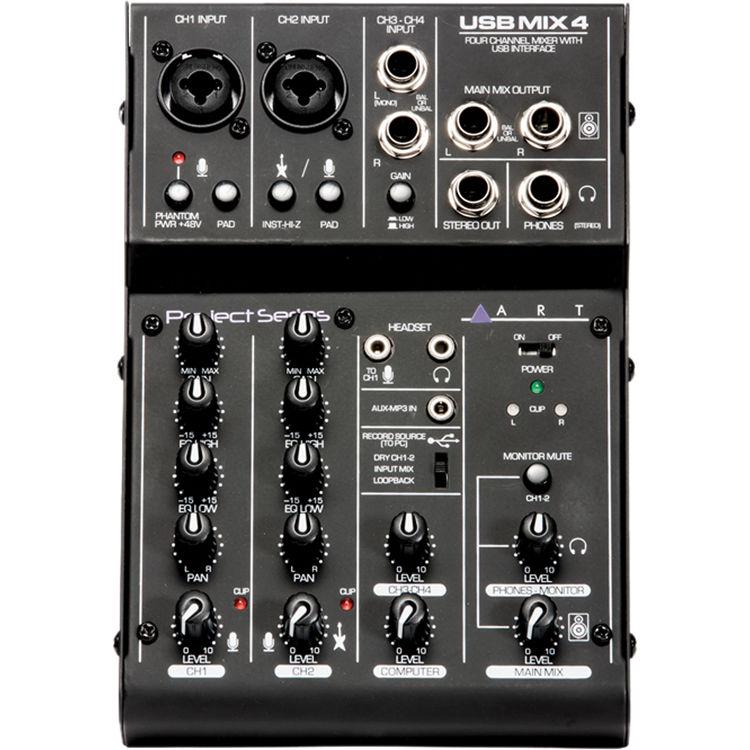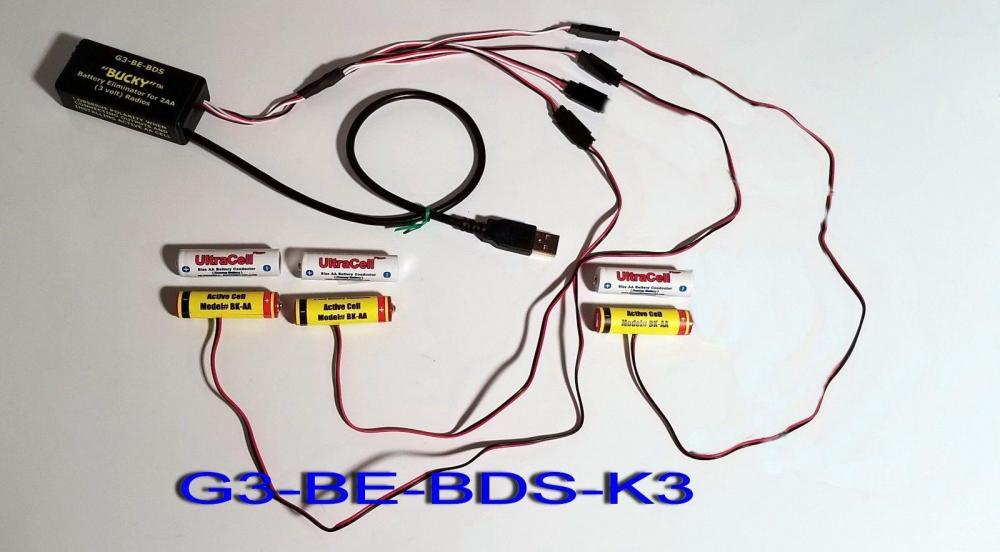
RevelRob
Members-
Posts
11 -
Joined
-
Last visited
Content Type
Forums
Gallery
Store
Everything posted by RevelRob
-
Adapting Sennheiser G3 wired mics for use with Sony UWPs
RevelRob replied to Tyler Neisinger's topic in Equipment
Although most of what you wrote completely goes over my head, I am inclined to think that you are correct. This is exactly what I did. I have been using the adapter I made (pictured a few posts above) since I made it, and have luckily had nothing but success. I know that it's not proper (hence, the "Dirty" label), and that there's potential for RF interference. You have just confirmed that. Thanks! That said, I have only used it to adapt a Sennheiser Headset Microphone to a Sony UWP Transmitter for LIVE performance; so if there were any issues, they were negligible. Unfortunately, I either can't disassemble the Sennheiser plug or don't know how to. It doesn't come apart like the adapter parts I have do. I assume that since I just reversed the tip and ring and left the shield floating, that my mic is a 2-wire mic? Also, according to this: https://sennheiseruk.happyfox.com/kb/article/104-ew-plug-pin-configuration/ it mentions only 2 wires of the ME3. Correct me if I'm wrong. I would love to make a proper adapter according to what you wrote; however, I am a bit confused by a couple of things and wanted to ask if what I am proposing is correct before I attempt to make another adapter: First off, I am primarily wanting to make a Sennheiser ME-3 Mic to Sony UWP Transmitter adapter. Not really worried about a Sony Mic to G3 TX adapter (but may eventually make one). I am much more of a visual person, so I adjusted the diagram to what I think may be correct. I really appreciate your help! Also, where you you suggest I physically put the resistor? Thanks again! -
Adapting Sennheiser G3 wired mics for use with Sony UWPs
RevelRob replied to Tyler Neisinger's topic in Equipment
Yeah sorry, I shouldn't have colour coded the connectors. Just confuses things. Also, on my 3.5mm Female, the long tab has a "T" on it and a multimeter test confirms it's for the tip. It may just be how Switchcraft does it. Just found the datasheet actually: https://www.digchip.com/datasheets/parts/datasheet/000/35LJN-pdf.php Also, on the Male adapter I'm using, the Tip is the one that the Tip arrow is pointing to. Us Canadians have it all reversed! That said, to simplify... Female Tip to Male Ring with either Red or White wire (diagram shows Red). Female Ring to Male Tip with Shield. Female Shield and Male Shield disconnected (diagram shows White wires floating on both ends). -
Adapting Sennheiser G3 wired mics for use with Sony UWPs
RevelRob replied to Tyler Neisinger's topic in Equipment
Thanks for your help Eric! Regarding the diagrams, they are both INCORRECT if wanting to make an ADAPTER. Here is the correct wiring for an adapter: It will work both ways but since the Shield is carrying the load of 2 wires (shield and ring wire of the G3), it may not be advisable to use it the opposite way. If you want to make one to adapt a Sony mic to a Sennheiser TX, I'd suggest just doing the wiring like above but put the shield where the red wire would go and the red wire where the shield would go. All that said... I may have no idea what I'm talking about. -
Adapting Sennheiser G3 wired mics for use with Sony UWPs
RevelRob replied to Tyler Neisinger's topic in Equipment
For anyone who is wondering, the above diagrams are incorrect if wanting to make ADAPTERS. After tons of trial and error and some amazing help by @Eric Toline and @Dalton Patterson, I ended up successfully making 1 adapter that will work both ways (G3 mic to UWP TX and UWP mic to G3 TX). If you want to make an adapter, you just need to wire Tip to Ring and Ring to Tip. Leave the Sleeve on both ends floating. Since the Sleeve is the part of both connectors that provide the most stability when soldered, be sure to use a good amount of heat shrink. Here's my adapter: I'll probably make another that's a bit longer and use a bongo tie to reduce stress on it since it is a bit top heavy. -
Adapting Sennheiser G3 wired mics for use with Sony UWPs
RevelRob replied to Tyler Neisinger's topic in Equipment
Sorry to revive an old thread. I'm trying to make 2 adapters. The mics I have are both Headset Mics: Sennheiser ME 3-EW Headset Mic (older version of the ME 3-II) for G3. Sony ECM-322BMP Headworn Mic for UWP-D. I feel like I'm on the right track but just want to confirm before I do some more soldering (made some boo boos)... Is this correct? Thanks! -
Franken-Mixer... Mixen-Stein... Am I crazy or is this possible?
RevelRob replied to RevelRob's topic in Do It Yourself
So I ended up contacting B&H and they shipped it out to me! That monster I planned to build in the first post has been scrapped and replaced with this: I plan to paint the board black but figured it would show well in the pictures. This literally checks off all of the boxes. I can have all 3 inputs (headset, handheld & iPad) sent to practically any system. I love how B&H included the Pelican 1400 too: I glued the headset case to the top lid of the Pelican so that it swings down. I plan to put a 4 port USB desktop charger in that open area to charge the NiMH batteries I am using in the 2 TXs and RX, and the Bluetooth Receiver. I'll also put all of the adapter cables in there as well. That little plastic tab you see left of the bodypack TX is a 12 AA holder that slides in under the TX. So much space in this case. So happy this worked out, and better than I had hoped. Thanks so much for all of your help! -
Franken-Mixer... Mixen-Stein... Am I crazy or is this possible?
RevelRob replied to RevelRob's topic in Do It Yourself
Thank you all so much for your help! So I have been doing some more research and found the PERFECT solution. Sony UWP-D. First off, I hear that it is better than Sennheiser in a similar price range. Sony has a dual (technically 3 or even 4) channel URX-P03D: It accepts 2 separate wireless channels AND a 3rd stereo channel through the MIC Input jack simultaneously. They sell a bodypack transmitter (for my headset), a handheld transmitter & an XLR Plug on transmitter. The receiver has an internal 3-channel mixer on board. You can also choose where all 3 inputs are routed to (output 1, output 2 or both). The "Phones" output is a line level output. The receiver can be powered via AA's, rechargeable batteries AND microUSB. This literally checks off all of my boxes! I wont even need to use that mixer! And no double wireless hop! I can just hand this receiver to the sound operator and be good to go. Since it has 2X mic and 1X line out, it can be adapted to be used with pretty much all 3rd party inputs (3.5mm, RCA, XLR, 1/4"). I can also use a Zoom/Tascam connected to one of the outputs to record the audio in case I want to film my show. Regarding my iPad, I can hook it up wired to the MIC Input in cases where I'm close to the sound board or use my battery operated Alto XLR Bluetooth Total Receiver on it: So... I was really really excited to pull the trigger on this... Then I see that all of the locations that the Sony site lists them for sale in Canada either don't sell them anymore (not even listed on their sites), are marked as "out of stock", or are selling only the ones in the +600MHz range (which will not be useable in under a year here). B&H sells them still; but they are listed as not being able to ship to Canada. Usually, this means that they are planning to release an updated version of this product soon, but I don't see any news of this anywhere. Hey, at least I'm getting closer and less "risky". -
Franken-Mixer... Mixen-Stein... Am I crazy or is this possible?
RevelRob replied to RevelRob's topic in Do It Yourself
True, it was not really a great analogy. I more meant that near perfect sound is less important to me than having a dynamic system that can be as close to perfect as possible in certain situations (where I can wire as much as possible); but still has the potential to work in difficult ones (where I'm forced to go wireless). Unfortunately, when it comes to wireless, it seems like there's the very low end, then the Sennheiser Evolution, then a huge jump to the ultra professional. I wish there was something between... That I can buy in Canada. The reason I'm on this forum is exactly that... To get professional knowledge and background tips. I'm also here to see if there are smarter alternatives that would achieve something close to what I'm trying to do, at a price point that won't break the bank. I absolutely want to try this; however, the reason I can't is due to that last hurdle: making the custom wires. Especially the one that goes from the Mixer Mains Out to the Sennheiser Transmitter. Without knowing this, I can't even try to see if it fails. From browsing these forums, I have seen a lot about DIY wiring for specialty situations. I haven't been able to find that anywhere else. Once again, all of your help is truly appreciated and I thank you all very much for it. -
Franken-Mixer... Mixen-Stein... Am I crazy or is this possible?
RevelRob replied to RevelRob's topic in Do It Yourself
First off, wow! Thanks so much for the quick replies everyone. I know that this is the case; however, because I'm in quite a niche market, my situation becomes a mish mash of techniques. Also, you all seem to know more about portability. The reason for using a USB power supply is to avoid wasting so many AAs (environmentally better and less cost). I also only have to worry about charging 1 thing. They are also easily replaceable and come in massive capacities at a small footprint. I'd always carry AAs and a power supply as a backup. Would it be better to use a field mixer power supply? Hardy har. 😉 The only reason I even considered full wireless is because I've been on a few small time reality TV shows where I see the A2's bag holding like 8 Sennheiser G3 RX's being used at the same time (yes, they were Sennheisers, not Lectrosonics). We were also constantly moving around in a dense city. Sure, they may have to find new frequencies often, but I don't mind doing that once per show via the G3's Easy Setup. So I figure using 3 at the same time is feasible. It's also done very often and there are documents on how to set up multiple systems with way more than 3 "systems". I think 8 is the max before you need antennas. Don't quote me on that though. I've asked my local pro film/tv dealers for advice; however, I'm either not going to the right places or they just don't know what they're talking about. They're mostly just salespeople. Me: "What would be the best way to convert Mic level to line level?" SP: "What do you mean?" Me: "Like... Hmm... Let me explain in a different way... How would I plug this microphone into this RCA jack?" SP: "Oh! We have this:" Me: "*Sigh*" I also own 2 Sennheiser G3 Camera Kits and they have never caused me problems... Well... Only once, before I found out that I should be setting new frequencies every time I changed venues. I would test it out by renting the additional equipment, but it's the custom wired cables that are the issue right now. Thanks Philip. I've just come to realize that in order to be as compatible with the most amount of equipment, I have to do something about it myself. I always scan new frequencies whenever I set up a show and haven't had any issues so far. Actually, even when I scan frequencies in my apartment that's filled with wireless devices, in the middle of downtown Toronto; most of the frequency banks that it finds show 12 available bands. Sure, the Sennheisers aren't the best at doing this, but still says something. And no, I'm not in an illegal band. I'm in band A which is 516 - 558 MHz. Also, I've had to set this up in places where they already have plenty of wireless mics on the same board and other wireless mics on different boards around the room (trade shows), and haven't had any issues. Yes, I know it is dangerous to do so, but so far, it's been pretty awesome. Thanks turtelot. It's a bit of a proof of concept more than anything. More to say "this is what I am trying to achieve, this is how I plan to achieve it, will it work or is there a better way?" Unfortunately, although I can forego most wireless (and will in situations where I can), I still have to have 1 wireless device which is my headset microphone. I need both of my hands to perform and I have to travel across the stage and into the audience all the time. My act is also very physical so I am constantly moving around. even when I'm standing in the same spot. I've tried to use a mic stand but it just changes my show so much that it's not possible. The situations vary so much, but there are a few different ones that I encounter. When I am feeding a house reinforcement system (theatres mostly), I will use their wired handheld mic, their 3.5mm stereo audio jack for the iPad, and plug in my headset mic RX. This is obviously the best situation and I wouldn't use this DIY "system" for that. Sometimes, I have to plug into a DJ system or the banquet hall's house system. More often than not, they either don't have any inputs for me at all or have only 1 input. If they don't have any because it's occupied by their own microphone, I have to get them to introduce me (because they don't have an input for my iPad which has my intro track), then wait for them to lower the mic volume, unplug their mic, plug in my mic, and then raise the volume before I start speaking. I know... insanity. Then, when I have a volunteer, I either have them yell their responses if the room is small enough, or just repeat what they say. Then, even if they do have an input for me, it can vary so much from system to system. I always hope that it's XLR to make it easier, but it's often RCA, 3.5mm, 1/4" stereo or 1/4" un/balanced. Then, I have to bring some adapters, mess with the RF out dB on the RX and hope for the best. Besides the obvious advantage of being wireless (I know, wireless=bad); the other reason for wanting to use the G3 to send mains to another system is that all I would need to do is carry the 2 cables that come with the G3s (XLR & 3.5mm) and it will adapt to any system via the RF out adjustment of the RX (correct me if I'm wrong as that's how I've been doing it now). If I wanted to do the same with a wired approach, I'd have to convert those Mains outputs to line level before being able to use it on either RCA or 3.5mm stereo would I not? That would require another piece of powered equipment. I guess I could also use the Headphone out too which is line level. The other scenario is when I have to provide my own sound for small to medium sized private parties. In this case, I have a battery operated PA that has a XLR-1/4" combo jack, 1/4" jack and an RCA input. See below pictures. This thing is great for smaller events but is pretty heavy. So really, in professional situations or when I bring the PA, I don't have to worry much about sound. I am more trying to make this for the not-so-professional situations where it is called for. Situations where this DIY "system", with all of it's caveats, is still better than the alternative (no music, no volunteer mic). Of course, if the DJ booth is right next to the stage, I'd wire my mixer to their system (with adapters), wire the iPad to my mixer, and wire the handheld mic to my mixer as well. Then, my headset would be the only wireless. But sometimes the DJ booth is on the opposite side of the room from the stage (with no snake), and if I'm sending 1 wireless signal already (my headset mic), I may as well send the other 2 as well. Or, send all 3 to the mixer sitting side stage while only sending the one signal from the mains to the DJ booth. My dream (in a perfect world) would be to make my own version of the above PA that has a latch-able "door". I could then put all of the components inside of it. Then, if using it with another system, I could use it as my monitor while also sending the audio to the DJ to play through the more powerful system. I know, It's not ideal with all of the wireless it would have but it would be pretty awesome in a perfect world. That and the fact that individual levels would not be able to be adjusted live. The filming would be for my use. I would put a camera on a stand and film to have footage of myself. Even though they aren't the greatest videos (production wise), having a recording of the microphone audio instead of the internal camera audio (which would pick up audio from the speakers while sitting at the back of the room), is better. Agents want video that isn't cut together. They want a beginning to end filming of the show so they can see everything as the audience sees it. Nothing wrong with adding better quality audio to it though. Another main reason I was looking at wireless is because wires often fail. Sure, they can last a very long time if handled with care, but I would have to carry so many wires and backups for them in order to achieve the same thing. A long XLR for the handheld mic (which people often trip over. Sure... gaffer tape, but I move around a lot. It's inevitable that an accident will occur.). A long 3.5mm cable for the iPad (See kicking wires. Easier to control due to no movement though). A medium sized 1/4" cable for mains/headphone out and all of the adapters for XLR, RCA, 3.5mm. If a cable is broken mid show, that dreaded crunching sound is just as bad as RF noise. Then, if the DJ booth is on the other side of the venue like certain situations, there's literally no fix and I'm back to square one. With this "box", all of the items will be pre-wired and contained in foam for minimum movement, no cable bending, no breakage, etc. All I would have to worry about in regards to wires would be the headset mic wire (my baby, which I treat very well and no one else touches), and the very short wire(s) from the G3 RX to the 3rd party system. Also, as an Illusionist, I am in a weird market. The types of shows I do vary so much. Sure, sometimes it's easy, they pay half decently well, and I can afford to arrive hours before. Unfortunately, many times, that's not the case. We tend to book multiple functions per night. So I don't arrive hours before the event to set up and wait until the event is finished to tear down. I show up about 60-90 minutes before showtime, introduce myself to the client, then the sound person; then I go back to my car to bring my equipment in (often up flights of stairs, or through snow, or from the opposite end of the parking lot because everyone has arrived already so there's no parking, or from the nearest parking facility a couple kilometres away because you can't find parking anywhere downtown in this city), then set up sound, then set up my props off stage. The more I can limit setup and teardown time, the better. The less trips I can make from my car, the better. Less time setting up means more time to perform another show. If I go the wired route, I'd have to worry about taping everything down while the event is going on and then tearing everything down once I'm done (not very professional). Making something like this would be easier to set up and smaller to carry. Sure, I'd bring along a bag of wires in my vehicle for emergencies; but I'd hope to not have to use them. Here's the thing... When filming, it's obvious that the tiniest issue in sound would be horrible. It has to be near perfect I'd think. When it comes to live performance, those tiny variances are barely noticeable. I'm not even singing which would call for a more professional approach. People just have to hear my voice, hear a volunteer say short sentences every once in awhile, and hear an intro track and some music that plays while volunteers are walking up to the stage. That may sound unprofessional, but it's also true. It's like someone getting a multi thousand dollar Dual Xeon Mac Pro to just browse the internet when an iMac will do the same for cheaper. Heck, you can buy a cheap used netbook and be able to carry it in a small backpack. Sure, the Mac Pro will do a better job at those things, but they will actually have a better experience with the netbook (portability, saved money). I know this may come off as "I don't care what you think because I'm gonna do it anyways", but I figure that since I already have everything on the list to make this besides the wireless handheld system, I may as well try it with a rented wireless handheld to see if it works. Again, it should be possible seeing those A2 field audio bags holding all of those G3s. All I need to do is figure out the wiring of the mains out to the G3 TX, the wiring for the Alta Bluetooth Total to channel 3/4 1/4", and the regular Sennheiser G3 XLR to 3.5mm Screw Lock wiring. I have 5 feet of BRTB Contour 3524 Premium Microphone Cable, a bunch of right angled XLR Male & Female connectors, right angled 1/4" TS & TRS connectors, Sennheiser 3.5mm Screw Lock Jack Plug Connectors, and some basic soldering skills. I just need to know how to wire em up. This may help. It's the Specifications page from the manual of the Mixer: Thanks again and I appreciate any and all help! (Wow I write a lot). Rob. -
Franken-Mixer... Mixen-Stein... Am I crazy or is this possible?
RevelRob replied to RevelRob's topic in Do It Yourself
Just realized that my questions weren’t really clear. I’m looking to have the following answered: 1. Is this stupid? Is going wireless from mic’s to the mixer then wireless from the mixer to the 3rd party system a bad idea? 2. Should I be doing this a different way instead? Like with a field mixer? Powered how they would be powered instead of USB? 3. How would I wire the following: 1. 2 X XLR to Sennheiser 3.5mm jack (regular way). 2. XLR to 1/4” TRS for Bluetooth RX. 3. 1/4” TRS to Sennheiser 3.5mm jack (for Mains Out to G3 TX). If too difficult to wire myself (seems easy enough. I’ve worked on PCB before), there’s a shop that makes custom wires near me. Thanks again. -
Hi, So I am a stage performer (Illusionist/Mentalist). The events I perform at vary so greatly with sound that I decided to take things into my own hands... hopefully. Here's a horrible mockup: My sound requirements are: 1. Headset Mic for me. 2. Handheld Mic for volunteers. 3. Music played from an iPad. Unfortunately, I often work at banquet halls where the client has hired a DJ who's system is very barebones (as most DJ systems are). It's not their fault. They usually don't have a need for a complicated system. Oftentimes, they will only have 1 input for me to use... and it's RCA 😵. I currently have a Sennheiser G3 ENG Camera Kit (EW112-P) and have replaced the ME-2 Lav with a headset mic. I love it. It's been very reliable. I am trying to build a kind of all-in-one system that will be compact, easy to set up, and... mostly wireless (I know. A lot of what I am going to talk about has to do with multiple wireless systems; however, I want to see if the idea I have is feasible first. Wires will always be carried as a backup). I have an ART USBMIX4. It is nice and small, has enough channels to satisfy my needs, and is powered by USB. Manual: My plan is to mount the above mixer in a case and hook up the following to it: Channel 1: My current Sennheiser G3 Headset Mic ENG Camera Kit. Channel 2: A (yet to be purchased) Sennheiser G3 or G4 Handheld Mic ENG Camera Kit. G3 EW135-P or G4 EW135-P Channel 3/4 (L Mono): Alto Bluetooth Total XLR with a custom XLR-F to TRS 1/4" cable. <- Gotta figure out how to do that. It's used to receive audio from my iPad that I control remotely with a pocket control. It sits on a stand facing me and feeds me information visually as well. Main Mix Output: Here's where it gets complicated... I'd like to output this mixer to ANOTHER G3 or G4 Camera Kit. Why? So that all I have to do when I speak to the DJ is ask what kind of input they have for me. If they say 3.5mm or RCA: I raise the RF out on the RX, connect the CL 1-N (3.5mm to 3.5mm), connect a 3.5mm to RCA (if needed), and tell them to plug it in and I'll do the rest. If they say XLR or 1/4": I lower the RF out on the RX, connect the CL 100 (3.5mm to XLR), connect an XLR to 1/4" TRS (if needed), and tell them to plug it in and I'll do the rest. This is not only wireless, but also has the advantage of not having to use a DI box or Amplifier to convert the 1/4" Balanced Main Mix Out to RCA or 3.5mm as the G3/G4 RX cables and RF out would do that for me (I think??). The trouble now is how to connect the Balanced Main Mix Out to the G3/G4 TX. I know I can't use the 3.5mm to 3.5mm Sennheiser CL 1-N and a 3.5mm to 1/4" adapter as the CL 1-N is wired for unbalanced summed line in (I think??). I figure my options are the following: Custom TRS 1/4" to Sennheiser 3.5mm jack cable wired the "balanced line" way as stated at the end of the article here (I think??). Custom 2 X TRS 1/4" Summed cable to Sennheiser 3.5mm jack cable. I don't know how to do this. I also don't know if this is necessary. I assume only to have both right and left channels sent. Hopefully it just needs to be one of the right or left Main Mix Outputs as I eventually would like to put this entire system in a home made box with a battery powered speaker in it and connect the second Main Mix Out to it. Then, if I am performing for a small crowd, I can use the monster all in one device to do everything; however, if I need to plug into another more powerful system, I can use the all in one device as my monitor, and send the other Main Mix Out via the Sennheiser G3 to the main board. The great thing about this is that if I ever have to plug into a proper mixer in a theatre, I can just take my bodypack TX and Main Mix RX and sync them to the same frequency to skip the monster all together. The theatre should have their own handheld and separate stage side input for the iPad (or I just hand them the Alta BT Total to have it wireless). I will most likely power the mixer, 2 Sennheiser RX and 1 Sennheiser TX (with either DC2's or a Bucky Battery Eliminator) from a half decent USB Power Bank. Sometimes my performances are filmed. If I know this ahead of time, I can easily connect a Zoom or Tascam to the Stereo Out or Phones Out to record my audio for a better quality video. I know this is a crazy post, but I actually had no idea how else to explain it. Thanks for any help! Rob.


